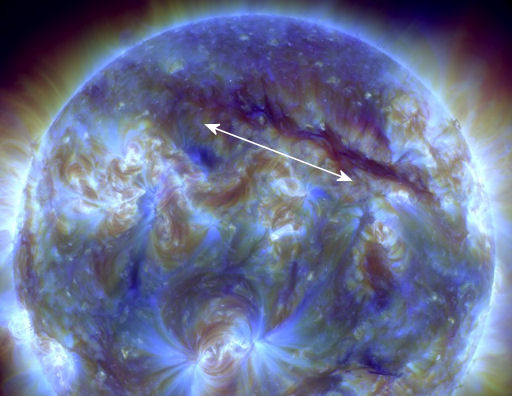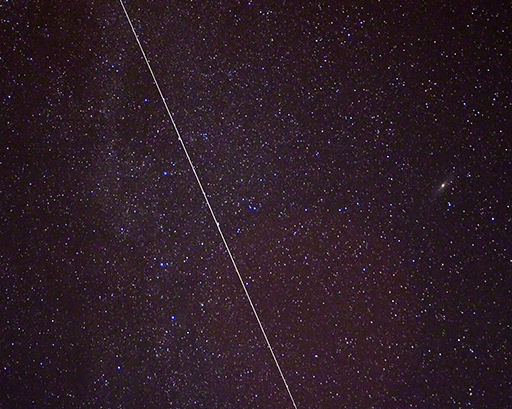Turn your cell phone into a field-tested satellite tracker. Works for Android and iPhone. | | | LEONID METEOR SHOWER: Earth is passing through the debris field of Comet Tempel-Tuttle, parent of the annual Leonid meteor shower. Barring a direct hit by a filament of dust, which forecasters consider unlikely, this year's shower should be mild. Peak rates of 10 to 20 meteors per hour are expected on Nov. 17th and 18th. [live counts] [meteor radar] GREAT FILAMENT: It's one of the biggest things in the entire solar system. A dark filament of magnetism measuring more than 800,000 km from end to end is sprawled diagonally across the face of the sun. NASA's Solar Dynamics Observatory took an ultraviolet picture of the structure during the late hours of Nov. 17th: 
If the filament becomes unstable, as solar filaments are prone to do, it could collapse and hit the stellar surface below, triggering a Hyder flare. Indeed, part of the filament already erupted on Nov. 16th, but Earth was not in the line of fire when the twisted lines of magnetism snapped. A similar event today would likely be geoeffective because of the filament's central location on the solar disk. Solar flare alerts: text, phone SHENZHOU 8 RETURNS TO EARTH: China's unmanned Shenzhou 8 probe returned to Earth on Nov. 17th, wrapping up a three-week mission to the Tiangong 1 space station. Shenzhou 8 spent its time in orbit practicing rendevous and docking maneuvers with China's new space station. Chinese authorities say the mission was a complete success. China's growing presence in Earth orbit may be seen with the unaided eye. On Nov. 14th, David Blanchard watched the Tiangong 1 glide past the Andromeda galaxy in the crystal-clear skies of Flagstaff, Arizona: 
"The space station zipped brightly across the sky, then swiftly faded away as it entered Earth's shadow," says Blanchard. "It was easy to see." The "Heaveny Palace" (Tiangong in English) will be making a series of bright flybys of North America in the nights ahead. Check the Satellite Tracker or your smartphone for local flyby times. Potentially Hazardous Asteroids ( PHAs) are space rocks larger than approximately 100m that can come closer to Earth than 0.05 AU. None of the known PHAs is on a collision course with our planet, although astronomers are finding new ones all the time. On November 17, 2011 there were 1256 potentially hazardous asteroids. Recent & Upcoming Earth-asteroid encounters: | Asteroid | Date(UT) | Miss Distance | Mag. | Size | | 2011 FZ2 | Nov 7 | 75.9 LD | -- | 1.6 km | | 2005 YU55 | Nov 8 | 0.8 LD | 11.2 | 400 m | | 2011 UT91 | Nov 15 | 9.9 LD | -- | 109 m | | 1994 CK1 | Nov 16 | 68.8 LD | -- | 1.5 km | | 1996 FG3 | Nov 23 | 39.5 LD | -- | 1.1 km | | 2003 WM7 | Dec 9 | 47.6 LD | -- | 1.6 km | | 1999 XP35 | Dec 20 | 77.5 LD | -- | 1.0 km | | 2000 YA | Dec 26 | 2.9 LD | -- | 80 m | | 2011 SL102 | Dec 28 | 75.9 LD | -- | 1.1 km | Notes: LD means "Lunar Distance." 1 LD = 384,401 km, the distance between Earth and the Moon. 1 LD also equals 0.00256 AU. MAG is the visual magnitude of the asteroid on the date of closest approach. | | The official U.S. government space weather bureau | | | The first place to look for information about sundogs, pillars, rainbows and related phenomena. | | | Researchers call it a "Hubble for the sun." SDO is the most advanced solar observatory ever. | | | 3D views of the sun from NASA's Solar and Terrestrial Relations Observatory | | | Realtime and archival images of the Sun from SOHO. | | | from the NOAA Space Environment Center | | | the underlying science of space weather | | 
